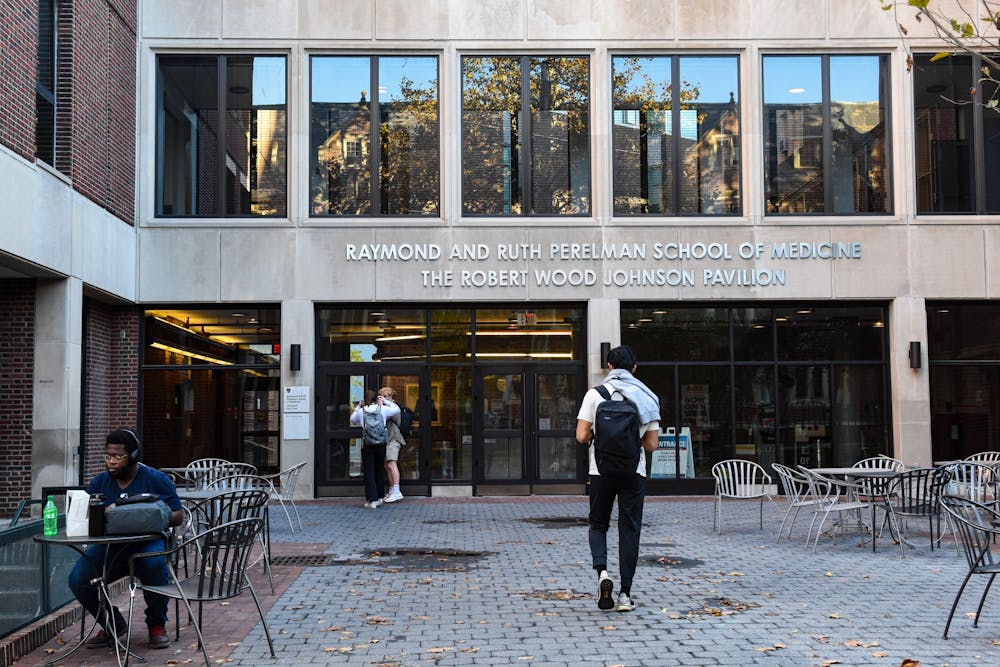
Eight medical researchers at Penn’s Perelman School of Medicine have received grants from the National Institute of Health’s High-Risk, High-Reward program, which aims to enable researchers to pursue questions with groundbreaking answers.
The Transformative Research Award, created to bolster multidisciplinary innovation, was awarded to a group of five Medical School scientists — Donita Brady, George Burslem, Luca Busino, Eric Witze, and Terence Gade — for their investigation into genetically mutated proteins in tumor cells.
They aspire to develop a new technology called the Probe Enabled Activity Reporting system, which could eventually be translated into a therapeutic drug.
In addition, Chengcheng Jin, Bushra Raj, and Amelia Escolano each individually won the New Innovator Award for their projects, which is intended to support cutting-edge medical researchers early in their careers.
Jin, an assistant professor of cancer biology at Penn, won $1.5 million in funding for five years from the NIH for her research on neutrophils, an immune cell abundant in the human body which protects against deadly infection.
When tumor cells enter the body’s ecosystem, Jin said, they are able to essentially “hijack” these neutrophils, reprogramming them to “remodel the tissue microenvironment so it’s actually easier for the cancer cells to grow.”
However, cancer therapy drugs cannot target these neutrophils without compromising the body’s immune system, leaving patients open to a high risk of fatal infection. With the money from the New Innovator Award, Jin plans to identify the pathways through which the tumor microenvironment is able to appropriate the neutrophils, and then suppress them.
“Our study is trying to understand how specifically the tumor microenvironment can reprogram these cells so that we can target these pathways to turn the neutrophils to their original function without affecting the good ones that are protecting from infection,” she said.
Jin said that she is motivated by the chance to save and improve lives, drawing her inspiration from the stories of affected patients.
“To hear a cancer survivor telling their experience, how they actually benefit from the research … they leave happily with their family,” she said. “Without the ideas researchers come up with, they wouldn’t have the chance.”
Jin is also grateful for the opportunity to collaborate with a diverse group of scientists. Coming from an undergraduate career at Tsinghua University in Beijing, she appreciates the way that science acts as a universal language.
“I’ve seen many backgrounds or cultural differences,” she said, “but we all come together for one goal, which is to cure cancer."
Brady and Witze are both associate professors of cancer biology, with backgrounds in chemistry and biology, and Gade is an assistant professor of radiology and cancer biology with a background in biophysics and noninvasive imaging.
The researchers emphasized the importance of harnessing the multidisciplinary expertise of their team members, approaching cancer from various medical perspectives.
“I think it’s a really unique feature of Penn,” Gade said. “I don’t think that it’s possible to bring together people from such diverse backgrounds scientifically everywhere. I think it’s one of the real strengths of Penn that it enables these types of collaborations.”
Their research focuses on utilizing chemical probes — molecules that can react with different proteins in a cell — to identify the genetic mutations which create the conditions for cancer growth between different patient samples.
Their study would allow for a more precise form of cancer therapy that would target specific genetic mutations, whereas most current cancer drugs target protein biomarkers.
“We’re wasting time,” Gade said. “We’re treating patients with drugs that are never going to work, because we’ve never asked the question ‘are the targets there?’"
This new approach is the kind of project that the High-Risk, High-Reward funding mechanism aims to support. It’s designed to let scientists think “outside the box”, Gade described.
Before receiving the NIH grant, the team applied for the Endeavor Award from the Mark Foundation for Cancer Research and were selected as finalists, but ultimately did not receive the grant.
“Going against the dogma of a field is challenging,” Brady said.
But after winning the New Innovator Award, the team is inspired to continue pushing medical boundaries.
“This is about a passion for science,” said Gade. “It’s not a job. It’s something that you live every day because you’re excited about it. I’d say we have the best jobs in the world because we get to wake up every morning and ask interesting questions.”
Jin, Gade, Brady, and Witze currently employ undergraduate students in their labs and emphasized that training the next generation of scientists is an invaluable aspect of their careers.
“I really enjoy working with my student postdoc trainees in the lab, because you see their growth as a scientist. It’s not just studying the disease itself, but building a scientific team to have the next generation of scientists interested in the topic and train them so that they can carry on this important kind of research,” Jin said.
The Daily Pennsylvanian is an independent, student-run newspaper. Please consider making a donation to support the coverage that shapes the University. Your generosity ensures a future of strong journalism at Penn.
Donate




